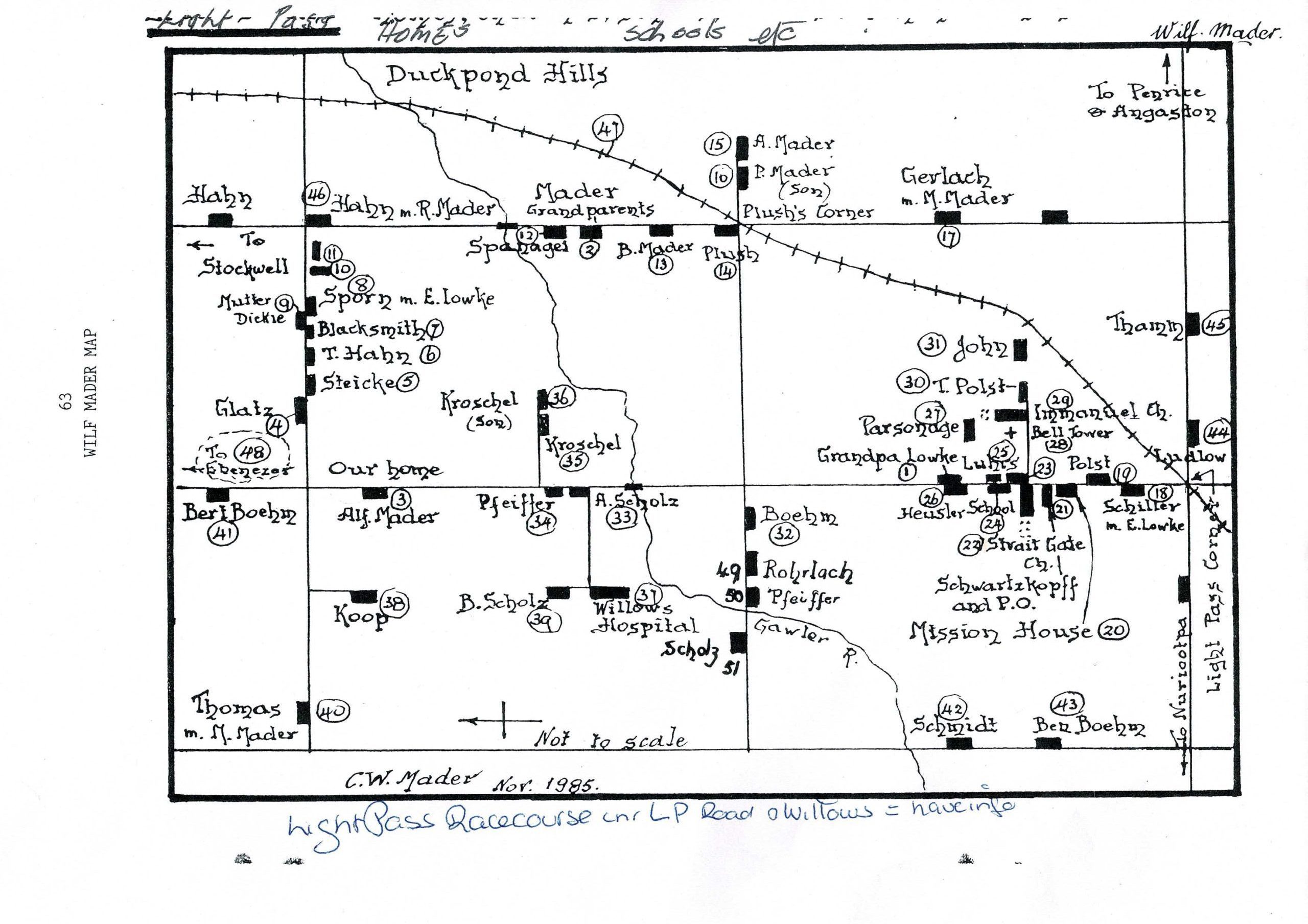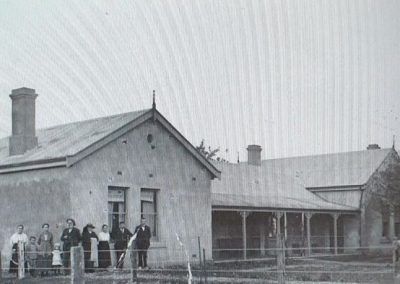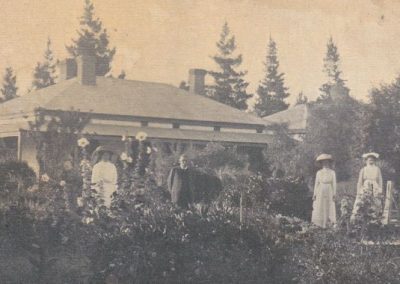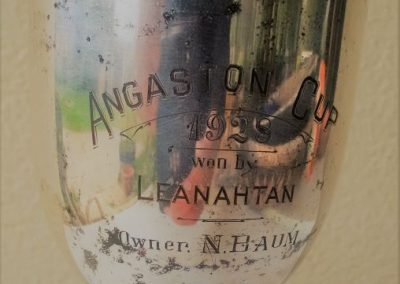If you wanted to step back in time to Light Pass in the 1920’s, you could do no better than to follow this map and guide. It was prepared by Wilf Mader, a Light Pass local, for the book Light Pass Revisited.*
The map is beautiful, and Wilf’s memory is amazing. So many interesting tidbits about the various places and their occupants. Find out who was the best fruit tree pruner in the district, whose houses were flood prone (no insurance available then, I guess), and who liked to sit on the verandah and play the accordion. Who was the first in the district to have electric lights (people were amazed to see an entire room lit up) and where would you go to get a hoe made for the garden? These, and plenty of other interesting facts await you – read on!
LIGHT PASS – Homes, Churches, Schools etc. as I remember them about 1920
by WILF MADER
- Grandfather Lowke: wattle & daub construction, dirt floors, very low bag ceilings, (whitewashed or kalsomined) 4 rooms. A number of small, straw covered sheds. One small shed had a wooden plank about 6inches wide, raised about 2 feet from the floor, for a toilet. The land was acquired by the S.A. Education Department, the house demolished, and a new Public School was built.
- Mader grandparents: large wattle and daub home, dirt floors, low ceilings. House below road level and therefore subject to flooding. Many sheds for farm implements (plough, harrows, rake roller), German Wagon, dray, trap, horses’ cows, pigs and poultry. Son Wilhelm lived here when he married.
- Our home: Alf Mader, five roomed house built of brick and stone, which Dad carted from Freeling. Wood floors, plaster ceilings, kitchen fireplace as well as Metters wood stove. A brick oven extended out from behind the open fireplace. Brick fireplace in the lounge. Straw covered sheds for cows (3) horse, hay, pigs, wood, poultry. Iron shed for pigs and poultry later. There was also a shed for our buggy and dray, and later for the T model Ford. Toilet, attached to woodshed, had a door, a wide plank with a hole for a seat, and a bucket which had to be emptied regularly. We used candles and kerosene lamps and later Aladdin kerosene lamps fitted with special mantles which glowed very brightly when alight giving a bright, white light. Out water supply was rainwater stored in three tanks. Used for drinking, cooking, and washing. A windmill pumped water from a well about 25 feet deep which Dad dug and bricked. The water was very good, and we used it for animals, vegetables and flowers.
In 1917 a large water main from Warren Reservoir was laid in the eastern side of the main road through Light Pass. This was cast iron pipe 151/2 inches in diameter and laid in a trench about 4 feet deep dug by a mechanical trench digger. The large pipes, about 20 feet long, were brought, three on a truck and placed along the route. The pipes provided much fun for us as we crawled through long tunnels. A permanent water supply was now available for residents. In the 1920’s a number of houses, including ours, had telephones installed. These were connected to the Nuriootpa Exchange.
- Glatz: small, galvanised iron house. Workman on Sporn’s farm. House probably owned by P. Sporn. 4 children
- Mr & Mrs Steicke: wattle and daub house (now in ruins). Mr Steicke a workman. 3 sons. Mrs Steicke lived to be over 100. (Note: this building is now part of Gibsons winery, the building has been partially restored).
- Ted Hahn: galvanised iron house owned by P. Sporn. Worked for P. Sporn. 2children.
- Sporn’s Blacksmith (note: unnamed?) with Sporn the Blacksmith. He was the general handyman effecting repairs to farm implements, shoeing, horses and often making garden and farm tools – spades, hoes, rakes, plough shears, wheel rims, brake shoes for wagons etc. (when I was about eight years old, I watched him make a garden hoe for me) There was a large bellow for the forge, charcoal and stacks of iron.
- Uncle Paul and Aunt Emma Sporn: large main house where the family lived – a split level solid construction house. A detached pug house, some 20-30 yards to the rear, included the kitchen and dining area, bakehouse, wash house, store house etc. The large kitchen had a very big wood stove and very long table-big enough to seat the family of nine (6 boys and 1 girl). Aunt Em provided breakfast, dinner and tea for all of these. It evidently was the custom to provide meals for workmen. Uncle Paul had a large farm, producing wheat, hay and wool from land in Light Pass and the Duckpond Hills. There were many draught horses and several buggy horses, sheep, cows, fowls and turkeys, pigs, and dogs. He tried to make the farm as complete and self-supporting as possible. There were numerous farm implements – plough, harrows, scarifies, drills, harvesters et. The latest and most modern available. A large stationary engine (kerosine I think) provided the necessary power for the chaff cuter and circular saw. The large horse stable adjoined the hay and chaff shed while the cow shed was quite separate, away from the house, on the eastern slope. In this way cleaning was made easy, although in winter it was very wet and muddy. A stallion, bull and rams were kept to ensure that progeny were produced. I can remember having to drive our cows, when on ‘heat’ to the bull on Uncles farm. I believe he was the first in the district to have an electric light plant. (The Willows Hospital may have had one before this). A large generator produced the electricity, which was stored in rows of thick rectangular glass jars about 15 inches high. We were always amazed when visiting our cousins to see a bright light illuminate a whole room by merely flicking a switch near the door. We had to shield a candle flame to provide every dim light when going from room to room. Uncle Paul also owned one for the first motorcars – a model T Ford in the district. Like ours, it was an open car with a collapsible hood. Rain and or wind could be kept out by erecting side curtains. The grey in colour was especially built large enough to carry his family of seven at that time, three in the front and four in the back.
- Mutter Dickie: old house, she often sat under her front verandah playing her accordion and singing.
- We knew it as ‘Shales” (?) house. A very old, wattle and daub structure, with low straw roof. Traugott Hausler lived here.
- Uncle Paul’s (Sporn) shearing shed built of galvanised iron.
- Pastor Spanagel a stone and brick house where he lived in retirement. I rarely saw him, believed he was a sick man and kept very much to himself, shielded by his wife. A small orchard, house in flood area, 2 sons.
- Uncle Ben Mader: stone house small orchard 2girls 1 boy
- Mrs & Mrs Plush: orchardists often sent fruit from railway siding known as Plush’s Corner owned a Morris Cowley car 1 son
- Uncle Adolph Mader: stone house orchard and vineyard, worked out vineyard, ploughing, pruning, clearing and picking on half share basis. Used a ‘dodger’ for clearing weeds between vines. 1 son 4 daughters
- Philip Mader (cousin)stone house, worked with his father
- Uncle Gerlach stone house orchard and vineyard, 8 sons 6 daughters
- Uncle Ben Schiller: stone house, kitchen separate from the house, many sheds, small farm orchard and vineyard. Lay read at Immanuel Church 5 girls 1 boy
- Mr & Mrs Polst: well-built old house, stone. Many straw covered sheds with their backs forming the fence along the road, orchard and vineyard 3 sons, 2 daughters
- Mission House: so, called because Lutheran missionaries from new Guinea came here on furlough, hence many changes of occupants. When my parent sold our property, they stayed here for several weeks while the new home on New Road Nuriootpa was being completed.
- Ben Schwartzkoff: house which runs at right angles to the road is built very close to the Mission House. He was the Lutheran School teacher also organist in the ‘Engen Pforte’ (Strait Gate) Lutheran Church. He was my teacher in the Evangelical Lutheran Church where Minna Hahn was the helper. Mrs Schwartzkoff had charge of the Post Office which was really part of their front room. Letters poster there were sealed in a post bag which was tied tightly with strong string and then sealed with red hot sealing wax. A driver from the Willows hospital collected this daily and delivered it to the Nuriootpa Post Office. After collecting many hospital Patients from the railway station, the in coming mail was brought to Light Pass and sorted ready for personal collection. 1 daughter.
- Strait Gate Lutheran Church: built after controversy in Immanuel congregation. Stone and brick construction with great bell in belfry. Pepper and pine trees planted in front of church provided shaded play area for school children. Church cemetery to rear of church. A small shed housed equipment and bier. Churchyard between Mission House. Post Office and Church was gravelled, Railing along western fence, and part of southern provided hitching for horses.
- Parsonage for Pastor of Strait Gate Church – stone. Pastor Stolz and family lived here, 4 boys, 2 girls.
- Evangelical Lutheran School built 1914. A squarish, stone building with a small porch at the front, windows on the south side. No wall blackboards, but two easels (one about 5’x3’ were the only chalk boards. Desks were 8’ long with no backs, there was a ledge underneath for slates and books. A moist rag or sponge was used to erase slate pencil work. ‘Helper’ Miss Minna Hahn taught the lower classes. Grade readers and ‘Children’s Hours’ were used for reading because library books were not existent. The ‘fall-in’ was conducted in front of the school, a flagpole with its flag was at the front entrance. Slates were used in the lower grades, exercise books in the upper school. Pen and ink were the writing materials, the ink was made by adding ink powder to water in a bottle and shaking vigorously, unless the bottle was tightly corked fingers and clothes often became ink stained. Misdemeanors were punished by scolding, standing in the corner or detention. In more severe cases the offending scholar was sent to find a small stick to be used as a cane. The traumatic walk often through the cemetery to find a suitable stick was often punishment and the teachers excuse not to use the cane. There was a small gutter between the school and the church on rainy days the small stream provided exciting sailing of many types of leaf and straw boats. The games we played included football, cricket, rounders, red-rover-all-over, drop handkerchief, last touch, knucklebones, marbles, keeps, eye-drop, follow the leader, 3-hole home, high cocka lorum, tip cat and hide and seek. When the school was taken over by the Education department, Mr McDonald was head teacher. The teaching of German was discontinued all lessons were now in English, the flag was saluted, and a departmental inspector visited the school: inspector Pavia was one. On fine days I often took my charges (about 16) outside under the pepper trees. A school photo was taken in 1916.After passing my qualifying examination I became a monitor at this school, I taught grade 1 and 2 for two years, Dan Corry and Charlie Verrall were Head Teachers. When I went to Adelaide High School (1924-1927) I boarded with Mrs Verrall, Charlie’s mother.
- Luhrs – first school I believe this is where Grandfather Lowke taught
- Hausler and vineyard
- Parsonage for Immanuel Church, Pastor Meier lived here. 3 boys, 2 girls
- Bell tower in Strait Gate Church grounds before new tower was added to church. The bell was supported by four large tree trunks and covered by a small iron canopy. The new tower was added in 1930, it was built by G.N. Dallwitz of Angaston and J.B. Traeger of Nuriootpa who did the carpentry work. My brother Laurie working for Mr Traeger helped to position the new bell (presented by JCF Zeunert) and the 8-foot finial on top. A difficult assignment so high above the ground. The bell from the old belfry was sold to the Cleve Church where Pastor Chris Stolz was stationed. The fine ne elegant tower with its delightful setting among the trees and vineyards is feature on many calendars and magazines.
- Immanuel Lutheran Church which we attended was built in 1886. Long pews were placed on either side of the aisle, women sat on the right and men on the left, the alter was in the central front position and ‘Kansel’ on the left. The Lemke organ was raised ‘Chor’ at the back of the church, candles were replaced by hanging kerosene lamps. The church cemetery is at the back of the church quite close to the parsonage.
- Ted Polst: vineyard and orchard
- Mr & Mrs John:
- Mutter Boehm: married son William also lived here.
- Albert Scholz: Chemist at Willows Hospital son of hospital proprietor. Made the renowned ‘Scholz Liniment. 1 boy, 2 girls
- Pfeiffer: worked for Kruschel
- Kruschel: farmer
- Kruschel: son farmer, owned one of the first motor cars no family.
- Willows Hospital: W H Scholz: Hospital for fractures, broken limbs, bruises etc. Always seemed to have many patients. Called ‘Willows Hospital” because of many weeping willows growing along the banks of the river which runs nearby. There are a number of buildings, the homestead, chemist’s lab (Albert Scholz), hospital section and outbuildings.
- Koop: vineyard
- Bert Scholz: masseur at Willows Hospital. Studied in America.
- Thomas: vineyard and orchard
- Bert Boehm: orchard and vineyard, brother of William and Ben, interested in Nuriootpa Band, became drum major. Expert fruit pruner especially apricots, judged fruit pruning competitions.
- Schmidt: farm, orchard, and vineyard.
- Ben Boehm: orchard and vineyard.
- Ludlow:
- Tham:
- Bert Hahn: farm (second owner)
- Railway: branch line from Nuriootpa to Truro through Light Pass ‘Plush’s Corner’, Stockwell, constructed in early 1920’s. A steam goods train ran several times a week and a ‘Barwell Bull’ rail car provided daily service to and from Nuriootpa and Adelaide.
- Angaston Racecourse: in P Sporns paddock, only used for a few years.
- Rohrlach:
- Pfeiffer: note as of 2022 this property still belongs to the Pfeiffer family
- Scholz:
* taken from Light Pass Revisited 1986 Wilf Mader pages 62-67. This record of the history of Light Pass was compiled for celebrations at Light Pass on 26th, 27th,28th September 1986 for the Jubilee ‘150’ of South Australia.




